
Pssst is an action video game developed and published by Ultimate Play the Game that was released for the ZX Spectrum in June 1983. In the game, Robbie the Robot has to protect his plant as it is attacked by various insects, each of which needs a different repellent to neutralise it. Pssst was the second game to be released by Ultimate, after Jetpac.

Sabre Wulf is an action-adventure game released by British video game developer Ultimate Play the Game for the ZX Spectrum home computer in 1984. The player navigates the pith-helmeted Sabreman through a 2D jungle maze while collecting amulet pieces to bypass the guardian at its exit. The player does not receive explicit guidance on how to play and is left to decipher the game's objectives through trial and error. Sabreman moves between the maze's 256 connected screens by touching the border where one screen ends and another begins. Each screen is filled with colourful flora, enemies that spawn at random, and occasional collectibles.
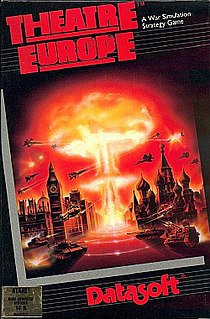
Theatre Europe is a turn-based strategy video game developed and published by Personal Software Services. It was first released in the United Kingdom for the Commodore 64, ZX Spectrum, Amstrad CPC and Atari 8-bit home computers in 1985. It was later released in France by ERE Informatique in 1986, and was released in the United States by Datasoft later that year. It was also ported to the Tatung Einstein home computer in 1989, exclusively in the United Kingdom. It is the fifth instalment of the Strategic Wargames series.

Ace of Aces is a combat flight simulation video game developed by Artech Digital Entertainment and published in 1986 by Accolade in North America and U.S. Gold in Europe. It was released for the Amstrad CPC, Atari 8-bit family, Atari 7800, Commodore 64, MSX, MS-DOS, Master System, and ZX Spectrum. Set in World War II, the player flies a RAF Mosquito long range fighter-bomber equipped with rockets, bombs and a cannon. Missions include destroying German fighter planes, bombers, V-1 flying bombs, U-boats, and trains. In 1988 Atari Corporation released a version on cartridge styled for the then-new Atari XEGS.

Nightshade is an action video game developed and published by Ultimate Play the Game. It was first released for the ZX Spectrum in 1985, and was then ported to the Amstrad CPC and BBC Micro later that year. It was also ported to the MSX exclusively in Japan in 1986. In the game, the player assumes the role of a knight who sets out to destroy four demons in a plague-infested village.

Tornado Low Level is a multidirectional shooter developed by Costa Panayi and published in 1984 by the company he co-founded, Vortex Software. The game was released for the ZX Spectrum in 1984, with ports for the Amstrad CPC and Commodore 64 in 1985.

Annals of Rome is a turn-based strategy video game developed by Level 9 Computing and published by Personal Software Services. It was first released in the United Kingdom for the ZX Spectrum, Amstrad CPC and Atari ST in 1986. It was then released in Germany for the Commodore 64 and Amiga in 1987 and 1988, respectively. The game revolves around the late Roman Empire and its objective of surviving for as long as possible against rebelling European states.

Battle of Britain is a turn-based strategy video game developed and published by Personal Software Services for the Commodore 64 in 1987. It was also ported to the Amstrad CPC and ZX Spectrum later that year. It is the seventh instalment to the Strategic Wargames series. The game is set during the Battle of Britain campaign of the Second World War and revolves around Britain's defence and prevention against a Nazi invasion. In the game, the player commands the Royal Air Force as they must defend key cities against the Luftwaffe.
Personal Software Services (PSS) was a British software company based in Coventry, founded by Gary Mays and Richard Cockayne in 1981. The company was acquired by Mirrorsoft in 1987. PSS produced video games for the ZX Spectrum, Commodore 64, Amiga, Atari ST, Atari 8-bit family, Amstrad CPC, Oric and IBM PC compatibles.
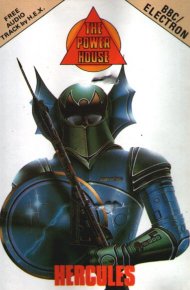
Hercules is a platform video game written by Steve Bak for the Commodore 64 and published by Interdisc in 1984. It was reissued in 1986 by Alpha Omega and ported to the Acorn Electron, BBC Micro, Commodore 16, Plus/4, and ZX Spectrum. Alpha Omega changed its name to The Power House shortly after publishing the game.
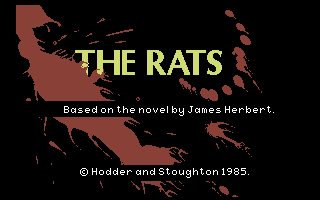
The Rats is a survival horror text adventure for the Commodore 64 and ZX Spectrum computers. It is based on the 1974 novel The Rats by James Herbert. The game was programmed by GXT, and published by Hodder & Stoughton, who were the publishers of James Herbert's book The Rats. An Amstrad CPC version was planned, but was never released.

Falklands '82 is a 1986 turn-based strategy video game developed and published by Personal Software Services for the ZX Spectrum and Commodore 64. It is the fifth instalment of the Strategic Wargames series. The game is set during the 1982 Falklands War and revolves around the Argentine occupation and subsequent British re-capture of the Falkland Islands. The player controls the British Task Force as they must either defeat all Argentine forces on the archipelago or re-capture every settlement.

Battlefield Germany is a turn-based strategy video game developed and published by Personal Software Services for the Commodore 64 released in April 1987. It was also ported to the Amstrad CPC and ZX Spectrum later that year. It is the eighth instalment to the Strategic Wargames series. The game is set during a fictional scenario in which the powers of NATO and the Warsaw Pact engage in a conventional war throughout Europe, mostly centring in West and East Germany.

Bismarck is a turn-based strategy video game developed by Personal Software Services and published by Mirrorsoft. It was first released for the Commodore 64 and ZX Spectrum in 1987 for the United Kingdom. It was ported to Amiga, Apple II, Atari ST and Atari 8-bit home computers in both the United Kingdom and the United States the following year. The game is the tenth instalment in the Strategic Wargames series. In the game, the player can choose to control either the German battleship Bismarck or command the pursuing fleet of Royal Navy ships.

Tobruk: The Clash of Armour is a turn-based strategy video game developed by Data Design Systems and published by Personal Software Services. It was exclusively released in the United Kingdom for the Commodore 64, ZX Spectrum and Amstrad CPC in 1987. It is the eleventh instalment of the Strategic Wargames series. The game is set during the 1941 Siege of Tobruk of the Western Desert Campaign in World War II and revolves around the Allied forces attempts to overthrow German field marshal Erwin Rommel from the city.
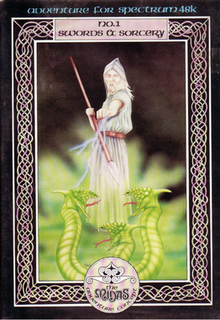
Swords and Sorcery is a fantasy role playing video game developed and published by Personal Software Services. It was released exclusively in the United Kingdom for the ZX Spectrum in 1985 and the Amstrad CPC in 1986. The game contains elements of dungeon crawling and revolves around a customisable player-character navigating through catacombs in order to secure a large wealth of treasure, whilst simultaneously collecting seven pieces of sacred armour.
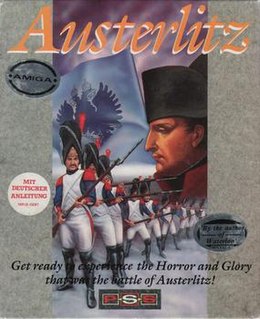
Austerlitz is a turn-based strategy video game developed by Personal Software Services and published by Mirrorsoft. It was released in the United Kingdom and Germany for the Amiga, Atari ST and MS-DOS home computers in 1989. It was also re-released in France for Amiga home computers by Mirror Image in 1991. The game is set during the Battle of Austerlitz of the Napoleonic Wars and revolves around Napoleon's forces defending the Austrian village of Austerlitz from the invading army of Alexander I of Russia.

The Battle For Midway is a turn-based strategy video game developed and published by Personal Software Services. It was first released in the United Kingdom and France for the MSX in 1984, and was re-released for the Amstrad CPC, Commodore 64 and ZX Spectrum in 1985. It is the second instalment of the Strategic Wargames series. The game is set during the Battle of Midway in the Pacific Ocean theatre of World War II and revolves around the United States Navy attacking a large Imperial Japanese fleet stationed at Midway Atoll, in retaliation for the attack on Pearl Harbor.

Pegasus Bridge is a turn-based strategy video game developed and published by Personal Software Services. It was released exclusively in the United Kingdom for the ZX Spectrum, Amstrad CPC and Commodore 64 in 1987. It is the ninth installment of the Strategic Wargames series. The game is set during the landings in Normandy on D-Day in the Second World War and revolves around the British 6th Airborne Division's attempts to secure a bridge over the Caen Canal.

Champion of the Raj is a turn-based strategy video game developed by Level 9 Computing and published by Personal Software Services. It was released exclusively in the United Kingdom for the Amiga, Atari ST, and IBM PC compatibles in 1991. It is the thirteenth and final instalment to the Strategic Wargames series. The game revolves around European imperialism and colonialism of India. Six factions–British, French, Mogul, Sikhs, Gurkhas, and Marathas–fight to gain overall control of India.




















